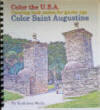Visit
a Time Machine at Patee House Museum
Story and Photos by Kathleen Walls

Patee House Museum in St. Joseph is like
entering a time machine of Missouri history. I stood at the
counter of the first Pony Express station and felt like I was
back in 1860. Patee House was the Pony Express Headquarters
when it began. Pony Express is the first thing that comes to
mind when most people think of St. Joseph, but Patee House
began several years earlier.
Patee House opened as a luxury hotel in
1858 and was the last upscale place to stay at before settlers
hit the trail into the unsettled west. There is a
well-preserved red stagecoach from the Central Overland
Stagecoach line that carried the mail before the Pony Express
speeded up the service.
I loved the exhibit of the covered wagons.
Just imagine packing all you owned into one of those wagons and
setting off for the unknown. Did you know Studebaker got its
start making covered wagons?
St. Joseph was a thriving riverboat town
and the last stop on the Hannibal St. Joseph Railroad. You can
step aboard Steam Engine Number 37 and feel as if you are
heading into the old west.
One section of the museum recreates the
streets of Old St. Joe in the 1860s-1880s. There's a drugstore,
barbershop, dentist office, bank, and post office. One business
that echoes into modern times it the dentist's office of
Frederick Cronkite, father of newscaster, Walter Cronkite.
There are many statues of the Pony Express riders. You can
enter most of the stores.
When the Civil War began, Missouri was
almost evenly divided. Some residents thought the South had a
right to leave the Union. Other disagreed. Missouri wanted to
remain neutral in the war, but neutrality was not acceptable to
rabid fractions on both sides. Militia units on both sides
raided and killed those perceived as enemies. Johnny Fry, the
first Pony Express rider who had enlisted as a Union soldier,
was killed in a skirmish at Baxter Springs by Quantrill's
Raiders.
After the war set enslaved African
Americans free, many of the men went west and enlisted as
Buffalo Soldiers. The exhibit there tells their story.
In the museum's Blue Room, there is a
collection of George Warfel Westerners on Wood portraits of the
people who figured in Missouri history. Some of the more
well-known are Frank and Jesse James, Doc Holliday, Cole
Younger, and Belle Starr.

The highlight is visiting the home where
Jesse James was shot on April 3, 1882, by one of his own men,
Bob Ford. It was a warm spring day and Jesse had taken off his
guns and climbed on a chair to straighten a picture. Bob and
his brother, Charlie, tried to collect the reward offered for
Jesse James but were instead arrested and charged with murder.
There is a replica of the gun used and a hole in the wall where
supposedly the bullet entered that had been enlarged over the
years by visitors trying to get an illegal souvenir.
Jesse had rented the small four-bedroom
frame house under the name Tom Howard for himself, his wife,
and two children. The house was moved from its original
location and sits next to the back door of Patee House.
Young
and old enjoy riding on the indoor vintage carousel. There are
three floors of exhibits so allow plenty of time.































